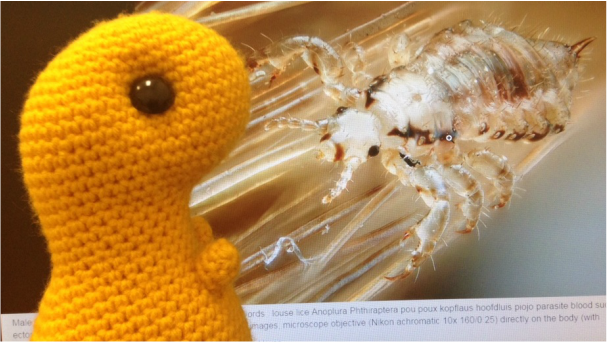 Mustard is curious about what parasites dinosaurs used to live with. This is a magnified human head louse - I wonder if dinosaurs had lice on their skin too? Image of head louse by Gilles San Martin, CCBY-SA 2.0, as seen on the Wikipedia 'head louse' page.
Mustard is curious about what parasites dinosaurs used to live with. This is a magnified human head louse - I wonder if dinosaurs had lice on their skin too? Image of head louse by Gilles San Martin, CCBY-SA 2.0, as seen on the Wikipedia 'head louse' page. The Microgastrinae are endoparasitoids of butterfly and moth caterpillars. A parasite is a living thing that must live on or in another living thing to survive. Some parasites you may have encountered before are animals like head lice, which live on human scalps and feed on blood. Mites, leeches and gut worms are other parasites you may have come across before. Parasites tend to keep their host (the living thing they are feeding from) alive.
Our wasps are endoparasitoids. Parasitoids, unlike parasites, end up killing their host to complete their life cycle, and the adult parasitoid is normally free-living (doesn't need a host to survive). The 'endo' part of their name means they live inside their host. An ectoparasitoid lives outside the host (for example on the skin or hair of animals).
A female microgastrine wasp will lay her eggs inside a caterpillar (sometimes just one egg, sometimes lots of eggs) and then leave them to develop. The eggs hatch and the baby wasps (called larvae) feed off the inside of the caterpillar as they grow. When they are fully grown larvae they chew their way through the skin of the caterpillar and crawl their way out! This kills the poor caterpillar, but the baby wasps have grown big enough to form a cocoon and change from a larvae to an adult wasp, starting the cycle all over again. It's disgusting and reminds me of something from a horror movie, but also incredibly fascinating!
Watch this amazing footage of a caterpillar infected with wasp larvae. The dialogue is in Spanish, but you can see the larvae burst out of the caterpillar, form cocoons and then emerge as adult wasps!
 RSS Feed
RSS Feed
